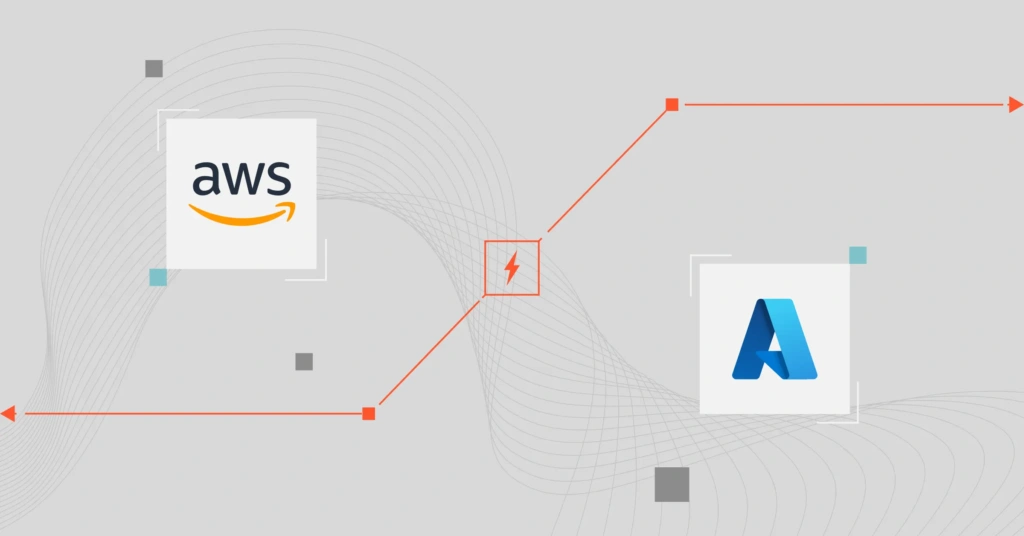Microsoft’s Azure and Amazon Web Services (AWS) are today’s two most popular cloud providers. They both offer a variety of Infrastructure-as-a-Service (IaaS), Platform-as-a-Service (PaaS), and Software-as-a-Service (SaaS) solutions.
In addition, you’ll find products covering multiple computing areas, such as compute, storage, analytics, and networking. You can also deploy AWS or Azure services in the cloud, on-premises, or as a hybrid setup.
It is still worth noting that each platform has a slight advantage over the other, particularly in terms of pricing.
The difference in pricing can save you thousands or increase your monthly cloud bill. This guide compares Azure vs. AWS pricing in more detail, including pricing models and what service plans are comparable.
The prices we’ve shared here are accurate as of the date we’ve published this guide. To stay up-to-date on cloud service pricing, we recommend checking the official AWS and Azure pricing pages or using CloudZero Advisor to choose the best AWS instances based on pricing, type, size, service, and more.
What Pricing Model Does AWS Use?
Most AWS services are pay-as-you-go. Most AWS services also don’t require contracts, upfront payments, or cancellation fees, so you can get started right away and customize them according to your needs.
You can also scale capacity up or down as needed.
Several other factors determine the exact rate you pay, including the service you subscribe to, the AWS region and availability zone, your payment plan, the amount of capacity you require, and what management level you opt for (managed versus self-service, for example).
There are five main pricing models for AWS services, depending on the product you select:
1. On-Demand pricing
With AWS On-Demand pricing, you pay for compute (vCPUs and RAM) and database capacity by the second or the hour. No long-term commitments. No upfront payments. But there is a minimum billing period of 60 seconds. The exact price will depend on which instances you choose to run.
AWS’s On-Demand pricing is the default billing model — and the most expensive. But On-Demand pricing allows you to pay only for what you use when you use it. Stopped instances do not incur charges.
Yet On-Demand pricing is the most difficult to forecast and, therefore, the most challenging to manage and optimize. To prevent overspending, you’ll want to use a robust AWS cost optimization platform like CloudZero.
2. AWS Savings Plans pricing
Savings Plans in AWS offer discounted rates of up to 72% off On-Demand pricing when you commit to a one- or three-year contract. A Savings Plan requires you to commit to an aggregate dollar-per-hour rate, such as $7.50/hour for one year. In case you exceed your allocated capacity at any point, AWS charges the extra capacity at the standard On-Demand rate.
Amazon EC2, AWS Lambda, and AWS Fargate instances are eligible for Savings Plans rates.
3. Spot Instances pricing
The Spot for Amazon EC2 pricing model lets you bid for and use spare AWS computing capacity at up to 90% off On-Demand pricing. No upfront commitment is required. Yet AWS can demand this capacity back anytime, giving only a 2-minute advance notice. Spot instances are, therefore, only suitable for interruption-tolerant workloads and temporary tasks such as background processing.
Yet, you can use tools like Xosphere, which automatically switches your workload between spot instances and cost-effective On-Demand instances in time to avoid downtime or high costs.
Alternatively, Spot Instance Advisor can help you select the best pool of Spot Instances to maximize your price-performance ratio.
4. AWS Reserved Instances pricing
Reserved Instances (RIs) in AWS can save you up to 75% off On-Demand pricing when you purchase capacity upfront to cover a fixed one- or three-year period. Purchasing capacity upfront gives you the biggest discount. Still, AWS allows you to pay nothing upfront or only partially for a smaller discount.
Check out this comparison between Reserved Instances vs Savings Plans to see the difference between the AWS discount pricing models.
Also, if you are struggling to choose the best compute RIs for your workloads on AWS, you can use a tool like ProsperOps, which automatically selects and orchestrates the right RIs for your needs.
5. Dedicated Hosts pricing
If you want enterprise-level security and reliability, you can rent dedicated servers from AWS for your private, dedicated use — at a higher price. AWS will clean and maintain the hardware for you.
What Pricing Model Does Azure Use?
Azure pricing varies depending on the type of service, location, payment plan, and capacity you use, just like AWS. For many services, Azure pricing follows a pay-as-you-go model, meaning you only pay for what you use.
You can pay for Azure Virtual Machines (Amazon EC2 equivalents) in four different ways:
1. Azure Pay-As-You-Go pricing
It works similarly to Amazon’s On-Demand pricing, where Azure bills you based on your actual hourly usage — no long-term commitments. There are no upfront costs. You can increase or decrease your Azure VM capacity anytime to meet your workload requirements.
This flexibility is helpful when you don’t know what your Azure usage will be in advance. Still, it can be challenging to control and optimize — hence the need to continuously monitor and optimize your Azure cloud costs with solutions such as CloudZero AnyCost.
2. Azure Hybrid Benefit pricing
This Bring Your Own License (BYOL) model enables you to use existing on-premises Software-Assurance enabled Microsoft licenses, such as Microsoft SQL Server and Windows Server, to get up to 85% discounts off Azure pay-as-you-go pricing.
Running Windows instances on AWS can be up to 5X more expensive than using your existing Windows SQL Server and SQL licenses with Azure. The reason is that you have to purchase Windows licenses separately when using AWS.
This discounting model is also available for SUSE Linux and RedHat subscriptions.
3. Azure Reserved VM pricing
Azure’s Reserved Virtual Machine Instances (RVMIs) offer a 72% discount off pay-as-you-go pricing when you reserve and pay for Azure for one or three years. Azure Cosmos DB, Azure SQL Database, Azure Synapse Analytics, App Service, and Azure Storage Reserved Capacity are among the services to which you can apply Azure RIs.
This option enables you to pay all upfront or monthly (reducing your upfront cash outlay). By combining RVMIs with Azure Hybrid Benefit pricing, you can save up to 80%.
4. Azure Spot VMs pricing
With Azure’s Spot VMs pricing, you can bid for and purchase spare Azure compute capacity at up to 90% off pay-as-you-go rates, similar to AWS Spot Instances. When Azure needs back its Spot VMs, you only have 30 seconds to switch to pay-as-you-go instances.
AWS Spot pricing also applies to more instances than Azure’s. You can still use Azure Spot VMs for various tasks, including batch jobs, rendering, development/testing, and advanced analytics.
Note: If you are a Visual Studio customer, Azure offers a discounted development/testing pricing plan depending on your chosen service. Also, Azure has a price-match guarantee on Amazon EC2 (against Azure Linux VMs), Amazon S3 Standard (against its Block Blob Storage ZRS Hot), AWS Lambda (against Azure Functions), and Amazon S3 Standard Infrequent Access (against Azure Block Blob Storage ZRS Cool) — although it can take up to 90 days to apply.
AWS Vs. Azure Cloud Pricing: Free Tiers
You can use either cloud provider’s free trial plan to assess whether it suits your budget and cloud computing requirements.
When you sign up for an Azure free account, you’ll receive $200 worth of credits that you can use toward two types of free services:
- 12 months of free use with varying limitations for compute, database, analytics, AI/machine learning, containers, media, integration, and networking services. For example, you’ll get 750 hours of burstable B1s VMs (compute) with Linux or Windows VMs for use within 30 days of signing up. After this trial period, you’ll need to pay up to continue using these services.
- Or, explore 40 Azure services for free forever across compute, database, security, containers, media, AI/ML, integration, analytics, management, IoT, and developer services. While some services are completely free and unlimited, like Azure Kubernetes Engine (EKS), Azure Batch, and Azure Advisor, some have usage limits, like Azure Functions (1 million requests cap), Azure DevOps (5 users), and Azure Automation (500 minutes job runtime).
In comparison, AWS organizes its free services into three categories:
- AWS free trials let you test a service for a specified number of hours, days, or maximum usage. Once this trial period lapses, the On-Demand rate (standard pricing) will automatically apply.
- The 12-month free usage option enables you to use various services with different limits until you reach your usage limit or 12 months after signing up for the first time.
- The Always free option lets you enjoy particular services free of charge forever.
AWS offers these free offers across compute, database, AI/ML, containers, serverless, storage, web, and apps services. Free Tier limits for AWS include 750 hours per month for Amazon EC2, 5GB for standard Amazon S3 storage, 750 hours per month of Amazon RDS database usage, 1 million free requests per month for AWS Lambda, and up to 1 million free publishes for Amazon SNS.
AWS Vs. Azure Pricing Comparison: Instances/VMs
Azure includes seven types of virtual machines, each comprising multiple VM sizes and series.
Each type of VM has its own pricing and is optimized for specific workloads. Here are some things to know about the different Azure VMs vs AWS instances:
Azure VM Type | VM sizes | Pricing | Use cases |
General Purpose | B, Dsv3, Dv3, Dasv4, Dav4, DSv2, Dv2, Av2, DC, DCv2, Dpdsv5, Dpldsv5, Dpsv5, Dplsv5, Dv4, Dsv4, Ddv4, Ddsv4, Dv5, Dsv5, Ddv5, Ddsv5, Dasv5, and Dadsv5 | B-Series VMs pricing starts at $3.80/month D-Series VMs pricing starts at $41.61/month | B-Series VMs are low-cost options for moderate to low CPU performance, like in dev/test and low-traffic web servers, but are burstable to accommodate increased demand D-Series VMs offer more balanced vCPU, RAM, and temporary storage to support most production workloads |
Compute Optimized | F, Fs, Fsv2, and FX | F-Series VMs pricing starts at $35.77/month | Designed for more compute-intensive workloads such as medium-traffic web and app servers |
Memory Optimized | Esv3, Ev3, Easv4, Eav4, Epdsv5, Epsv5, Ev4, Esv4, Edv4, Edsv4, Ev5, Esv5, Edv5, Edsv5, Easv5, Eadsv5, Mv2, M, DSv2, and Dv2 | E-Series VMs pricing starts at $58.40/month M-Series VMs pricing starts at $1,121.28/month
Mv2-Series VMs pricing starts at $16,286.30/month | E-Series VMs are suitable for heavy in-memory apps like SAP HANA M-Series VMs deliver up to 4 TB of RAM on a single VM for memory-intensive workloads Mv2-Series VMs are hyper-threaded and offer the highest spec for memory-heavy workloads at up to 416vCPUs and 3/6/12 TB of RAM |
Storage Optimized | Lsv2, Lsv3, and Lasv3 | Ls-Series VMs pricing starts at $455.52/month | Best choice for apps that require low latency, large local disk storage, and high throughput performance |
GPU Optimized | NC, NCv2, NCv3, NCasT4_v3, ND, NDv2, NV, NVv3, NVv4, NDasrA100_v4, and NDm_A100_v4 | N-Series VMs starts pricing at $657/month | Top choice for graphic and compute-intensive workloads like high-end visuals with predictive analytics |
High-performance compute | HB, HBv2, HBv3, HC, and H | H-Series VMs pricing starts at $581.08/month | High-performance VMs for HPC apps, such as financial analysis and simulations |
Memory and Storage Optimized | Powered by V3 family of Intel Xeon E5 processors | G-Series VMs pricing starts at $320.47 | Optimized for power-demanding use cases, such as large data warehouses. Deliver 2X RAM and 4X SSD compared to General Purpose D-Series VMs. |
Table: Microsoft Azure virtual machine types, sizes, pricing, and best use cases
Here’s an example of the cost of different Azure General Purpose D-Series VM configurations:
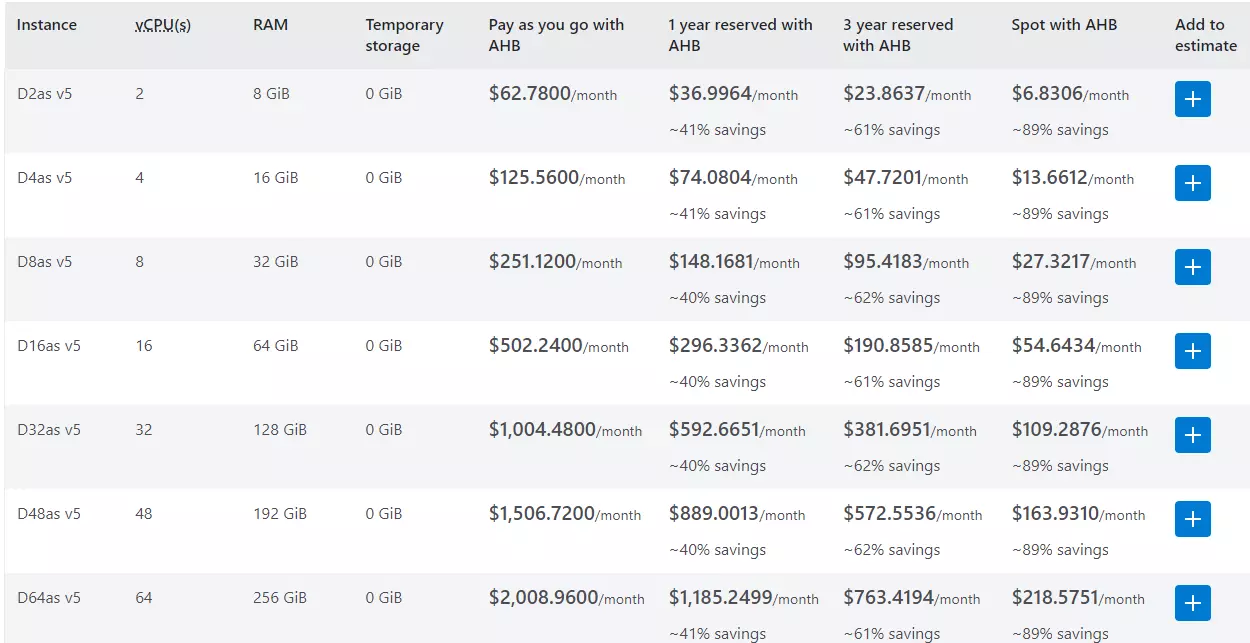
Azure Cost Calculator
AWS instances and Azure VMs offer mostly similar instance categories. However, because of the differences in machine generations and technologies, you may experience varying performance between AWS instances and Azure virtual machines.
This can complicate comparing prices side-by-side, although Azure offers to price-match AWS instances (within 90 days).
Here are a few things to keep in mind about AWS instances vs Azure VMs so you can compare them more fairly.
AWS Instance Type | Instance size | Pricing | Use cases |
General Purpose | Mac, T4g, T3, T3a, T2, M6g, M6i, M6a, M5, M5a, M5n, M5zn, M4, and A1 | Varies | Handle most workloads that require a balance between vCPU, RAM, and storage needs, like web servers and |
Compute Optimized | C7g, C6g, C6gn, C6i, C6a, Hpc6a, C5, C5a, C5n, and C4 | Varies | Powered mby Arm-based Graviton3 processors for high-performance computing, from running large web servers to batch processing workloads |
Memory Optimized | R6a, R6g, R6i, R5, R5a, R5b, R5n, R4, X2gd, X2idn, X2iedn, X2iezn, X1e, X1, High Memory, and z1d | Varies | Designed to support fast performance when processing large data sets in memory |
Accelerated Computing | P4, P3, P2, DL1, Trn1, Inf1, G5, G5g, G4dn, G4ad, G3, F1, and VT1 | Varies | Optimized for graphics processing, calculations, and pattern matching thanks to their hardware accelerators and co-processing features |
Storage Optimized | Im4gn, Is4gen, l4i, l3, l3en, D2, D3, D3en, and H1 | Varies | Best for use cases that demand low-latency and high, sequential read/write access to enormous data sets on local storage |
Table: AWS instances pricing — AWS prices instances depending on the amount of vCPUs, RAM, and storage you set up.
Both platforms support hundreds of vCPU, RAM, and network configurations. Moreover, both AWS and Azure offer high-end capabilities that currently max out at:
- Amazon EC2 instances: Up to 448 vCPUs and 24,576 GB of RAM. AWS also offers a wider selection of instance sizes (nano, micro, small, medium, large, Xlarge, and 2Xlarge) than Azure. Below is an image showing different sizes of AWS General Purpose T-Series instances as one example:
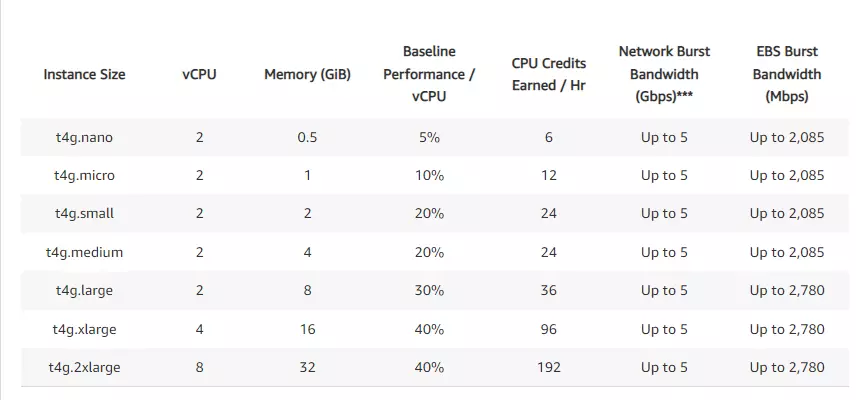
Microsoft Azure VMs: Up to 416 vCPUs and 11,400 GB of RAM. There are five sizes of Azure virtual machines: extra small, small, medium, large, and Xlarge. The following image shows how Azure specs those VM sizes:

If you want a more precise estimate of the cost of your configuration, you can use either the Azure cost calculator or the AWS cost calculator.
And if you need help determining which AWS instance types, sizes, and pricing are most suitable for a specific AWS service, CloudZero Advisor provides that and more in a few clicks.
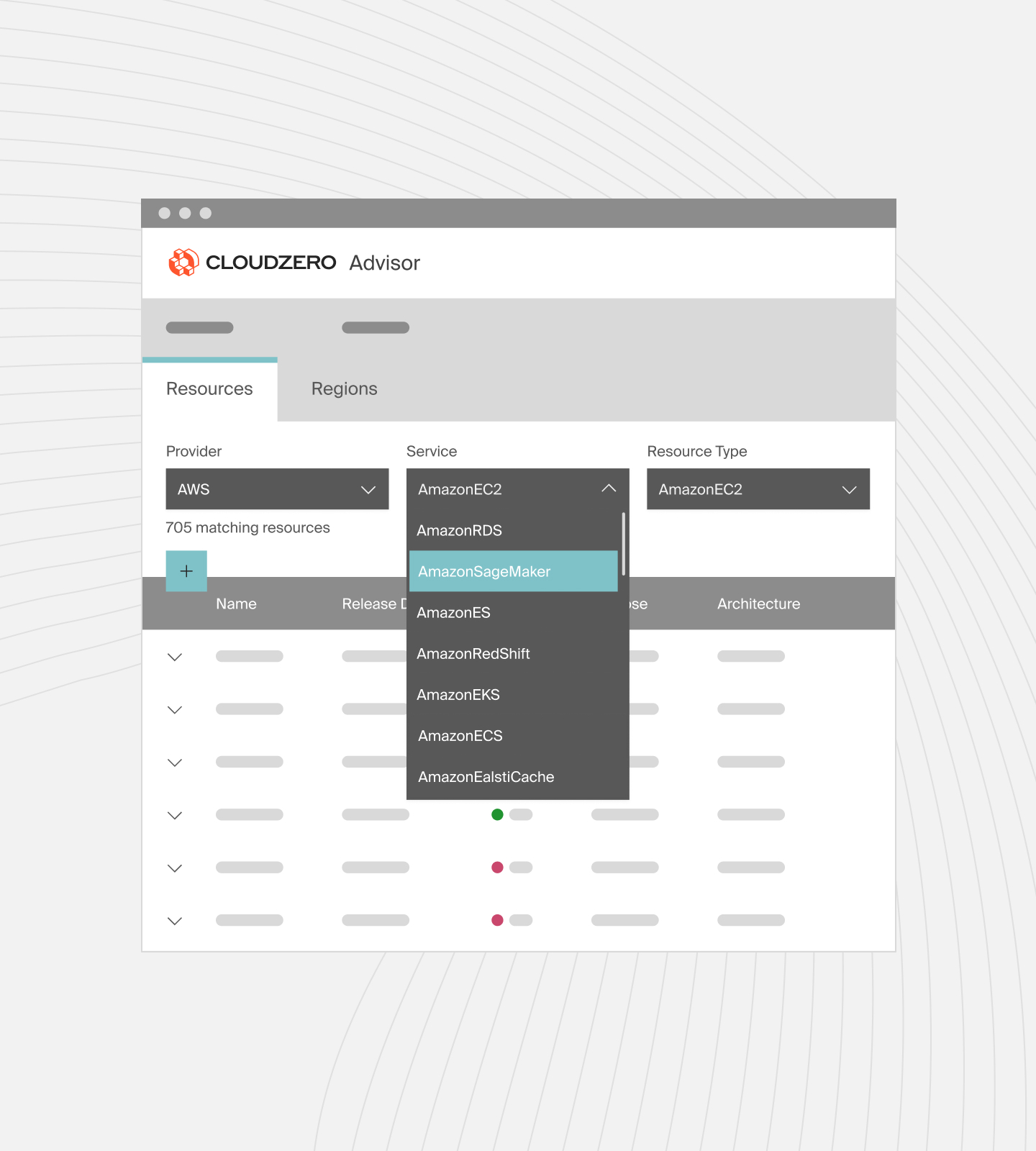
CloudZero Advisor is a free tool that helps you choose the best instance types, sizes, and pricing by service, like Amazon EC2, ElastiCache, and more.
AWS Vs. Azure Pricing: Support Plans
You can choose from four AWS cloud support plans, split between premium and free tiers. Everyone can access free support through self-service channels, such as AWS documentation, 24/7 customer service, and whitepapers.
There are four levels of premium support: Developer, Business, Enterprise On-Ramp, and Enterprise. The pricing starts at $29 per month and goes up to $15,000 per month, or 3% of AWS monthly usage.
Pricing for Business, Enterprise On-Ramp, and Enterprise tiers is based on percentage AWS usage, which decreases across brackets, as you can see here:
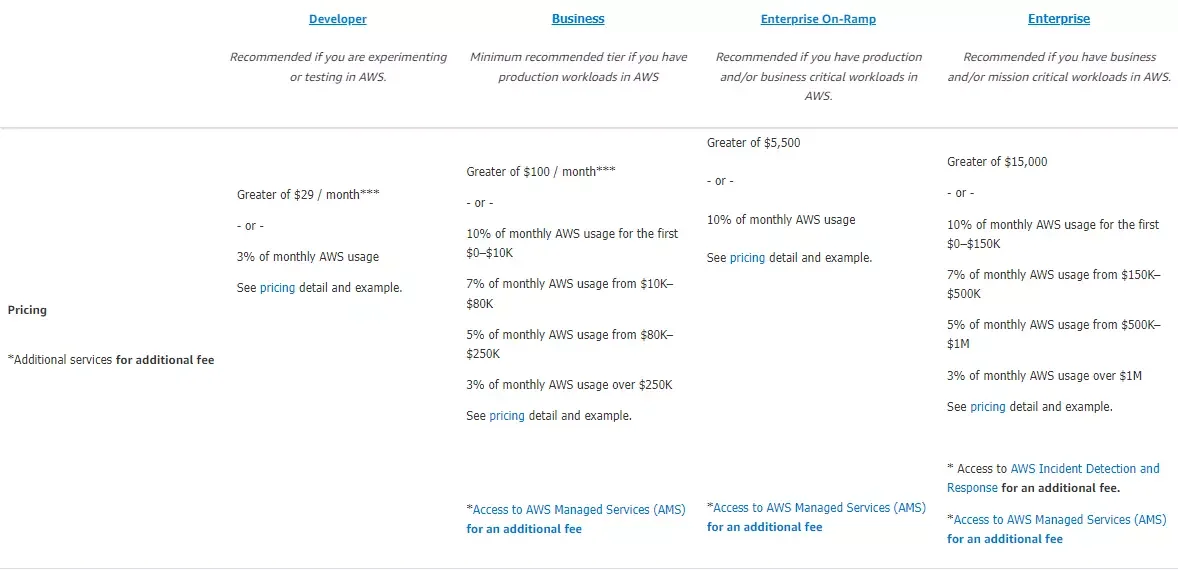
Credit: AWS Customer support pricing plans
As you upgrade across the tiers, you’ll get more support options, such as:
- Checks for best practices
- Adding more channels of communication
- 24/7 support availability
- Resolve issues within 15 minutes of a business-critical outage
- Support API
- A variety of training resources
- Having access to a Technical Account Manager
The premium plans also enable you to choose which products/services you want premium support, ensuring you pay for the assistance you require.
For Azure cloud support plans, expect four: Basic, Developer, Standard, and Professional Direct. Basic support is available free to all Azure customers.
The premium Developer, Standard, and Professional Direct support tiers are use-case or role-based and charge $29 per month and all the way up to $1,000/month per user. Check this out:
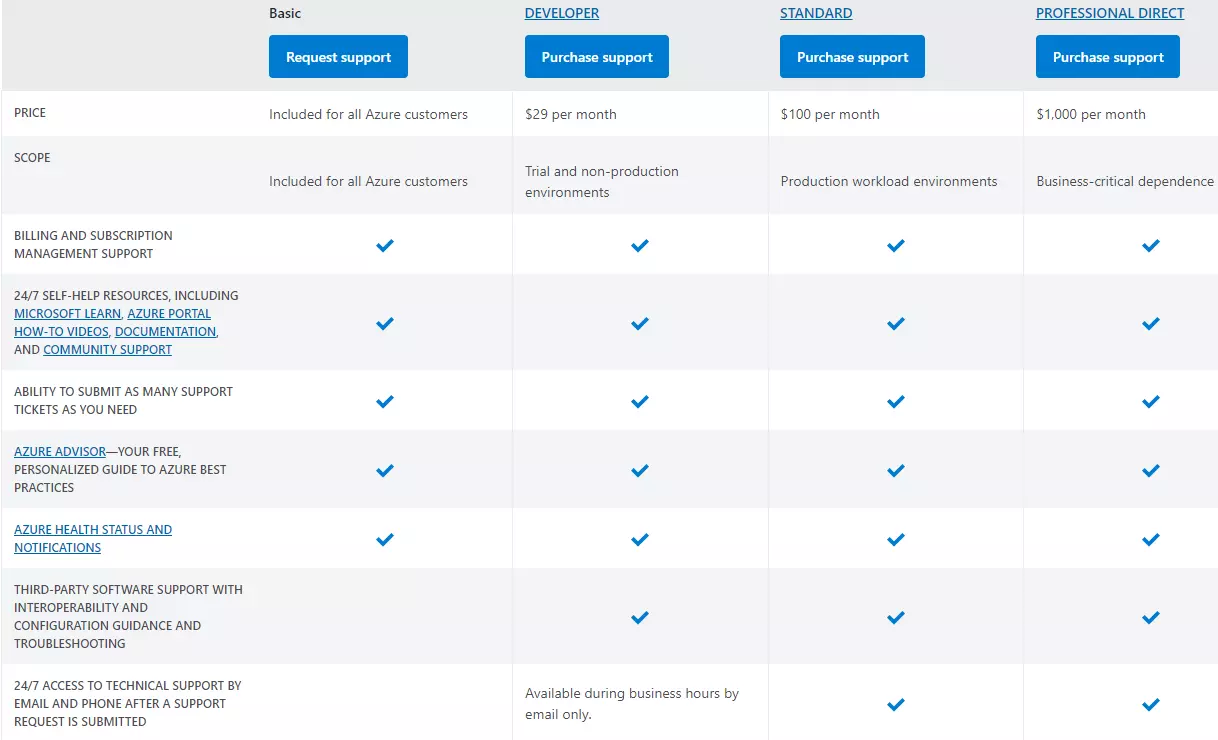
Credit: Microsoft Azure customer support pricing plans
Each level upgrade will improve your support options, such as adding more communication channels and faster response times.
Is Azure Cheaper Than AWS?
It is wildly inaccurate to compare Azure VM pricing vs. Amazon AWS instance pricing without context because there are many factors to consider. But since you came here to compare prices, we’ll share a list based on several factors.
Azure: Linux (Ubuntu or CentOS), General purpose, Dasv4 Series VMs, East US region, per Hour pricing
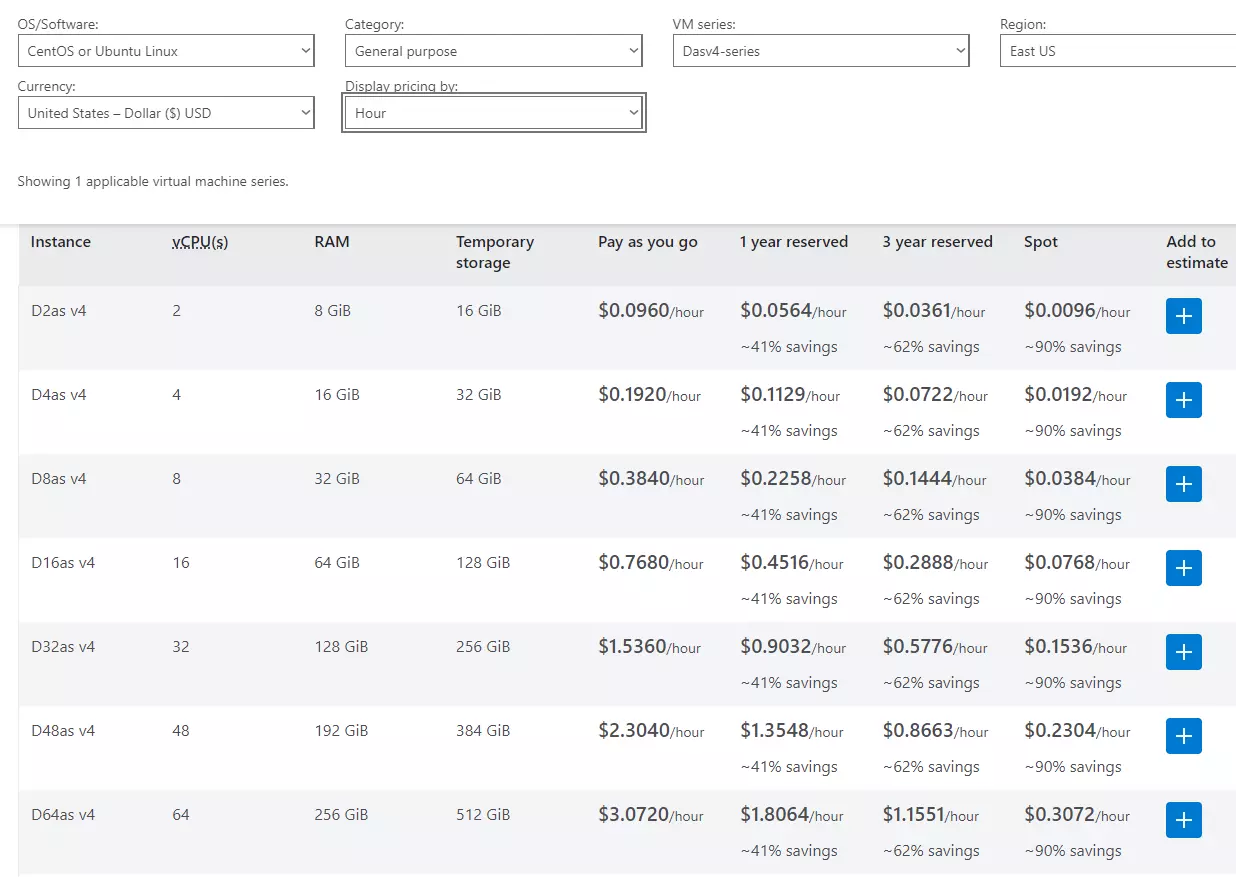
Compare that to AWS instance pricing for Linux, General purpose, 4vCPU instances, US East (Ohio) region:
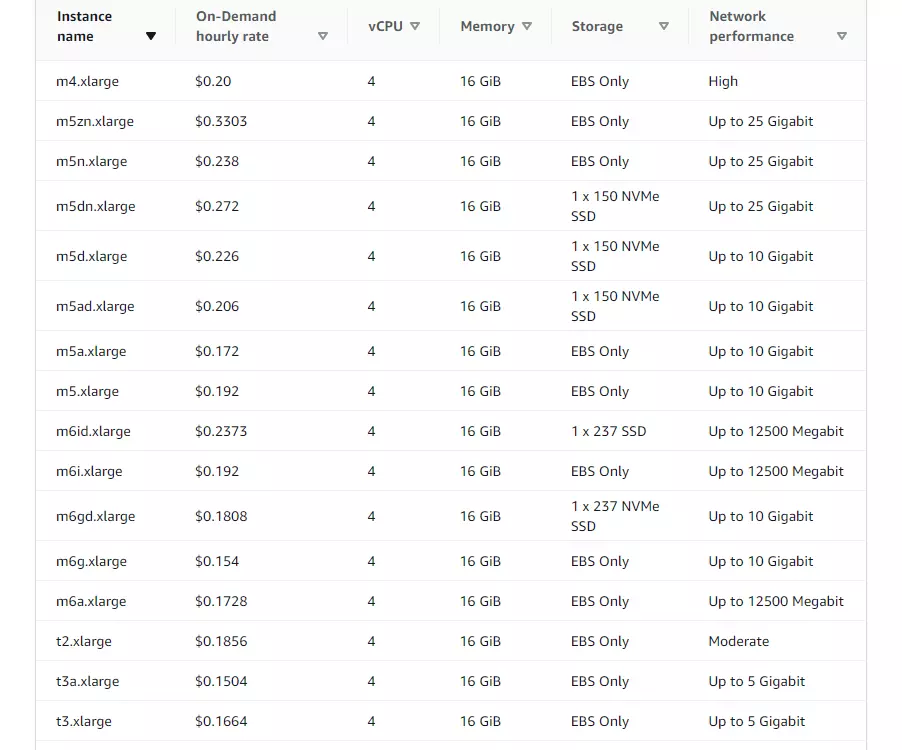
T4.Xlarge instances cost $0.01344 with 4vCPU/16GiB/EDS only/Up to 5 Gigabits networking
Here’s how much you’ll pay for the same configuration using reserved instances (1 year/shared tenancy/partial upfront payment plan):
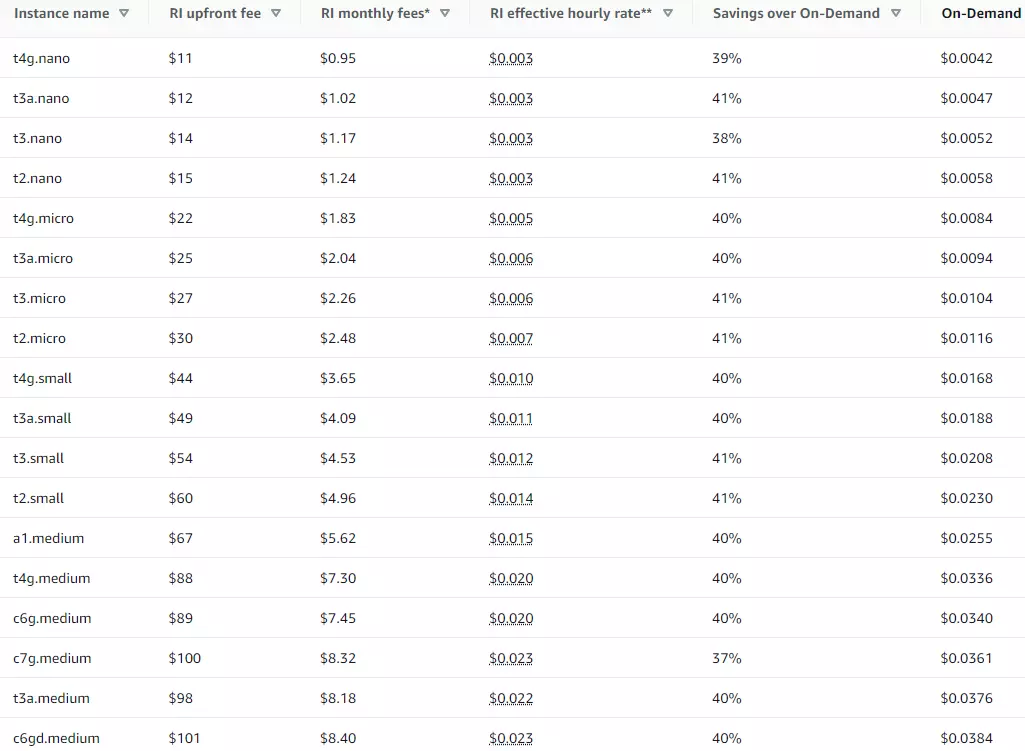
The following is how that would work out for a 3-year AWS general purpose/Linux/US East (Ohio)/shared tenancy/partial payment plan:
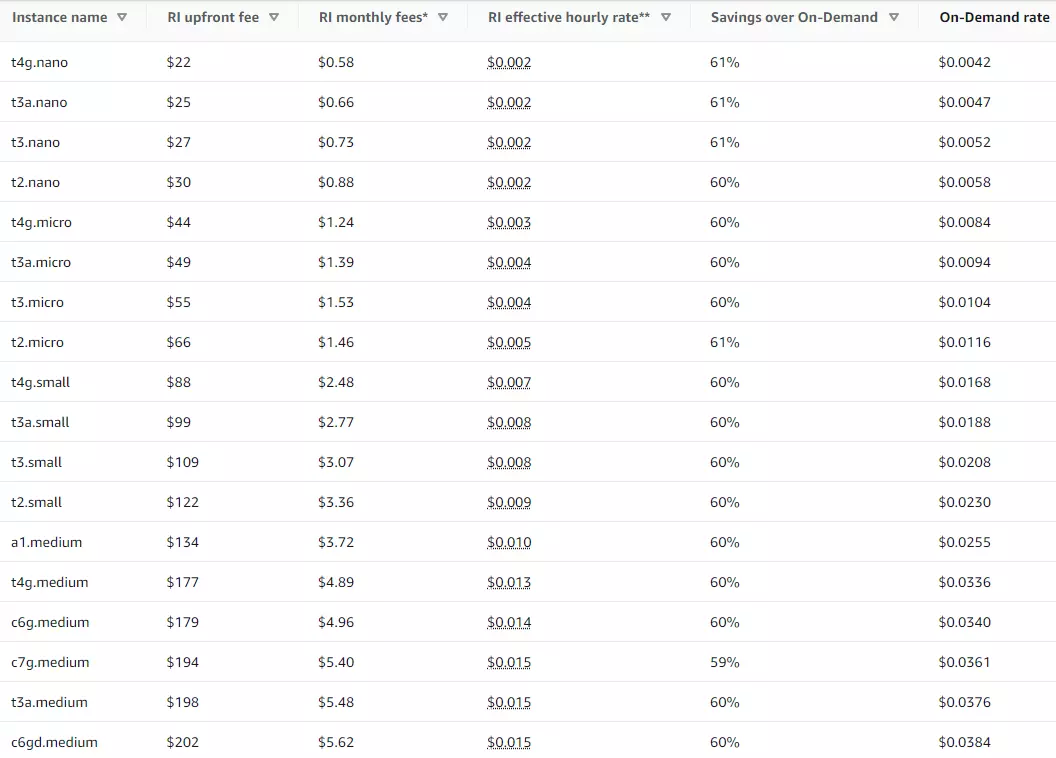
Again, these figures may change at any moment, so be sure to check CloudZero Advisor (which is up-to-date) or consult AWS’s and Azure’s official pricing pages.
The same applies to compute-optimized, memory-optimized, and graphics-optimized virtual machines. You can also compare Azure and AWS storage pricing this way. Contrary to what you may read on some blogs, these prices do not compare side-by-side without context.
For example, on the surface, Azure pay-as-you-go VMs may seem more affordable than AWS On-Demand instances, but Azure may not have comparable VMs in terms of performance. As another example, while AWS RIs offer higher discounts than Azure’s, AWS may charge higher fees for data transfers out.
But stress not — whether you’re using Azure or AWS, there are ways to keep your cloud spending under control.
Strategies To Lower Either AWS Or Azure Costs
AWS and Azure offer scalable cloud services, but the costs can escalate if not managed effectively. Here are proven strategies to reduce costs on both platforms, supported by expert recommendations.
1. Rightsize your resources
One of the most effective ways to lower cloud costs is by right-sizing resources. Both AWS and Azure provide flexible VMs and storage options. However, over-provisioning or underutilization of resources can inflate costs.
The solution?
Use built-in tools to analyze current usage. AWS’s Cost Explorer can show daily and monthly usage patterns, helping to identify over-provisioned resources. Azure Advisor identifies idle or underused virtual machines and suggests resizing.
2. Use cost allocation and tagging.
With this AWS, you can set up cost allocation tags to organize billing data and ensure team accountability. Azure Cost Management integrates with Azure Policy to enforce tagging across your resources, making monitoring and optimizing costs easier.
3. Auto-scaling and load balancing
Both services offer auto-scaling features to adjust resources based on demand automatically. AWS Auto Scaling helps maintain performance while optimizing cost by scaling up during peak times and down during low traffic. Similarly, Azure’s Autoscale adjusts VMs or App Services automatically based on usage, reducing the need for manual scaling.
4. Optimize storage solutions
Cloud storage is necessary but can be costly when not optimized. Both AWS and Azure offer tiered storage options based on access frequency.
AWS S3 has different storage tiers. These include S3 Infrequent Access and S3 Glacier for cold data, which are far cheaper than standard storage. Azure offers options similar to AWS’s with its Azure Blob Storage Tiers. These include Hot, Cool, and Archive storage. Cool and Archive tiers provide significant savings for rarely accessed data.
5. Turn off unused resources
Idle resources, such as VMs, storage, and no longer needed databases, can add up costs. Regularly audit your cloud environment to ensure unused resources are turned off or deleted. AWS Trusted Advisor and Azure Advisor both identify idle resources.
6. Leverage Reserved Instances, Spot Instances, Free Tier, and discount programs
AWS offers Savings Plans, and Azure offers Reserved VM Instances, both of which can potentially save up to 80%. AWS Spot Instances or Azure Spot VMs can also reduce costs by up to 90%. Both services also provide free-tier access to various services. Startups, nonprofits, and educational institutions can also benefit from additional discount programs.
Enough Said
Hopefully, you now better understand how AWS and Azure pricing work and the strategies to optimize these costs. The one lesson you should remember is this: compare prices on a case-by-case basis, or you won’t get a reliable comparison.
Next, we’ll examine some of the other common services offered by AWS and Azure and their pricing factors.
Pricing Factors For Popular AWS And Azure Services
Both AWS and Azure offer over 200 services. Here’s a breakdown of some of the most widely used services and the pricing factors for each platform.
AWS services:
AWS service | Pricing factors | Pricing |
| Standard Storage: $0.023/GB Infrequent Access: $0.0125/GB Glacier: $0.004/GB | |
|
| |
|
| |
|
| |
|
|
Azure services:
Azure service | Pricing factor | Pricing |
Azure DevOps |
|
|
Azure Virtual Machines |
|
|
Azure Blob Storage |
| Hot: $0.0184/GB Cool: $0.01/GB Archive: $0.00099/GB |
Azure AD |
|
|
Azure CosmosDB |
|
|
What next?
How To Understand, Control, And Optimize Your Azure And AWS Cloud Costs
Azure and AWS both provide native cost management tools to help you manage your costs. Cost Explorer, Trusted Advisor, and the AWS Cost and Usage Report are some of AWS’s cost tools. Azure offers Azure Cost Analysis, Advisor, and Budgets.
The problem with these native tools is that they do not provide cloud costs in a way that actually reflects how you use your cloud resources. For example, they aggregate all your cloud costs into one bill, denying you the ability to determine what, why, and who is driving your costs.
Without this granular understanding, it’s tough to tell where you are losing money or where you could improve profitability.
Wouldn’t it be great if you could view your AWS or Azure costs in an actionable, easy-to-digest format like this:
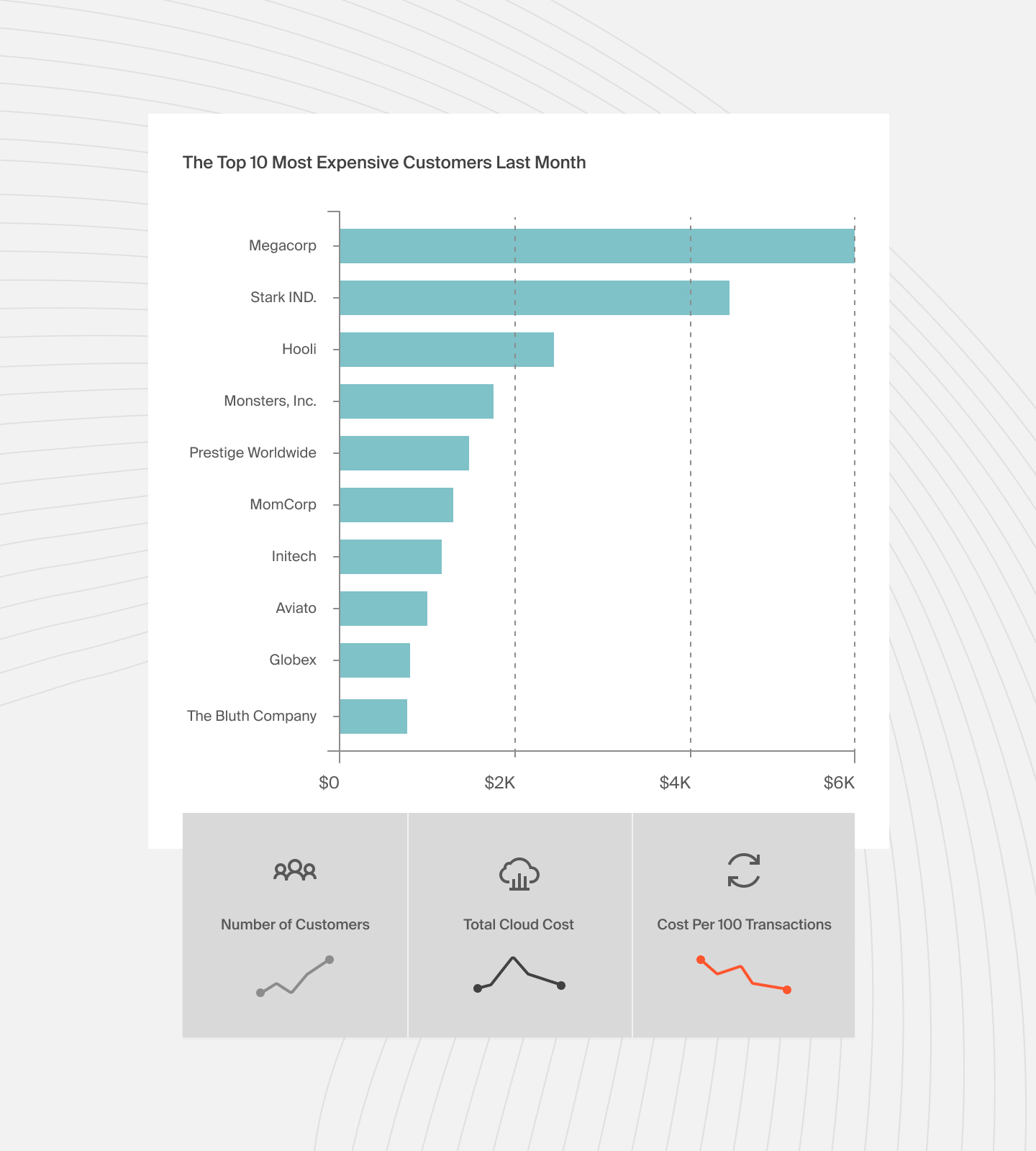
With CloudZero’s cloud cost intelligence approach, you get an easy-to-understand view of your costs and their relationship to your people, processes, and products. By understanding what drives your AWS or Azure bill, you can pinpoint where to cut costs or allocate more resources to maximize your return on investment. No manual cost allocation tags are required.
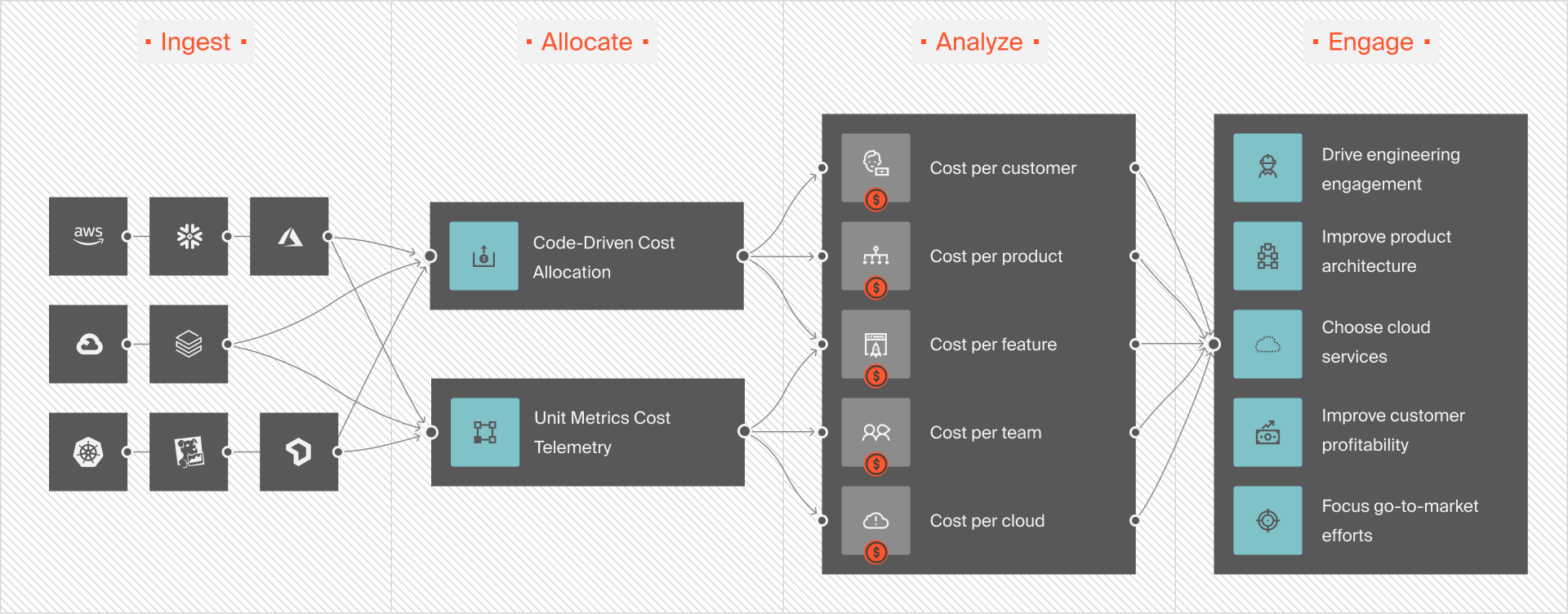
You can view your costs based on dimensions you care about, such as cost per customer, cost per product, cost per software feature, cost per team, cost per environment, cost per development project, and more.
CloudZero AnyCost enables you to gather, analyze, and understand your AWS and Azure costs on the same platform, allowing you to compare and optimize.
So, maybe you want to deploy your workloads on both platforms to take advantage of their pricing differences. With CloudZero AnyCost, you can easily view, control, and optimize your cloud costs for Azure, AWS, Google Cloud Platform, Kubernetes, Snowflake, and more, all in one place.
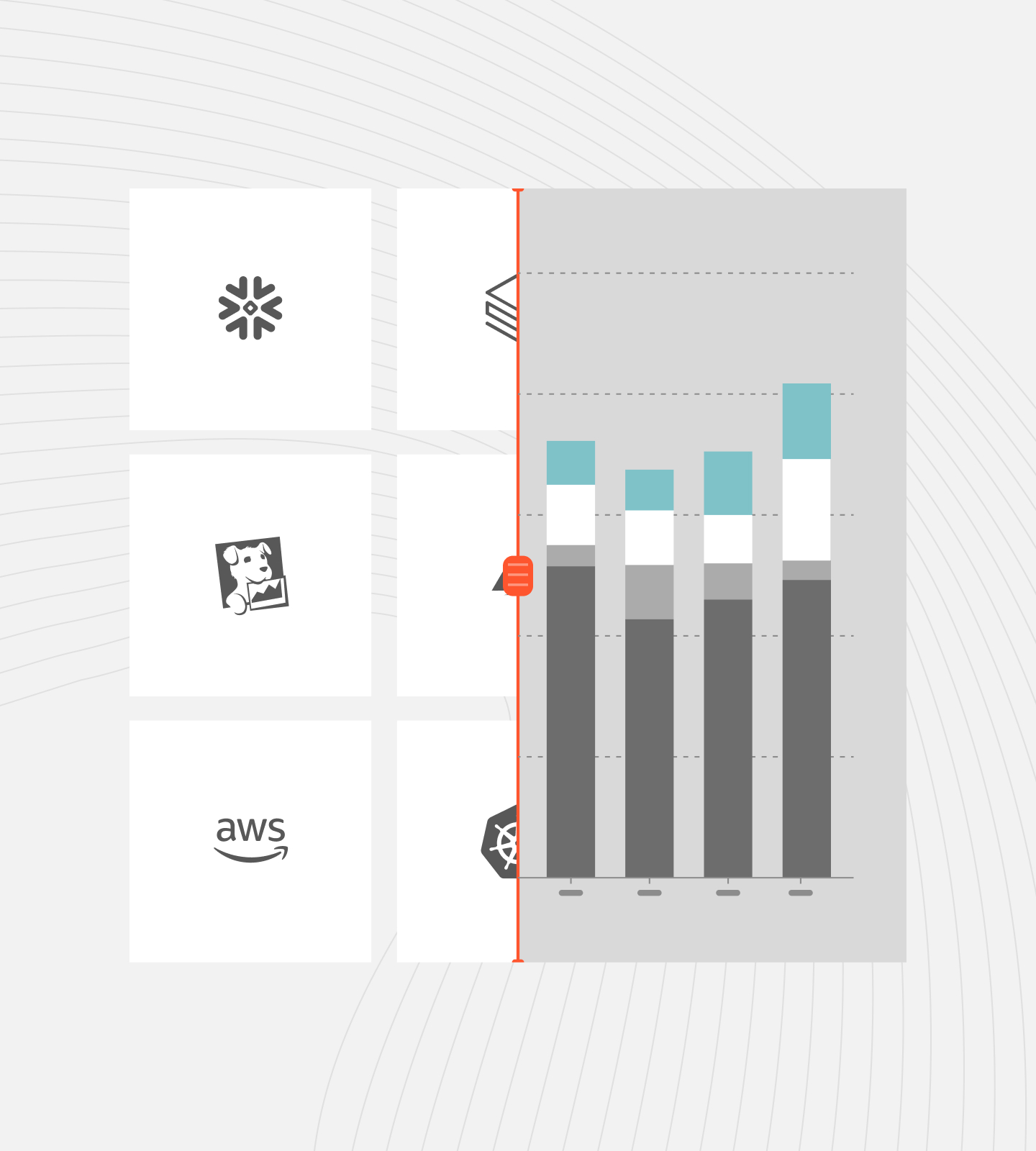
One more thing. As part of CloudZero, you can also set up Budgets and take advantage of Cost Anomaly alerts, which notify you when you are nearing your set Azure and AWS budget.
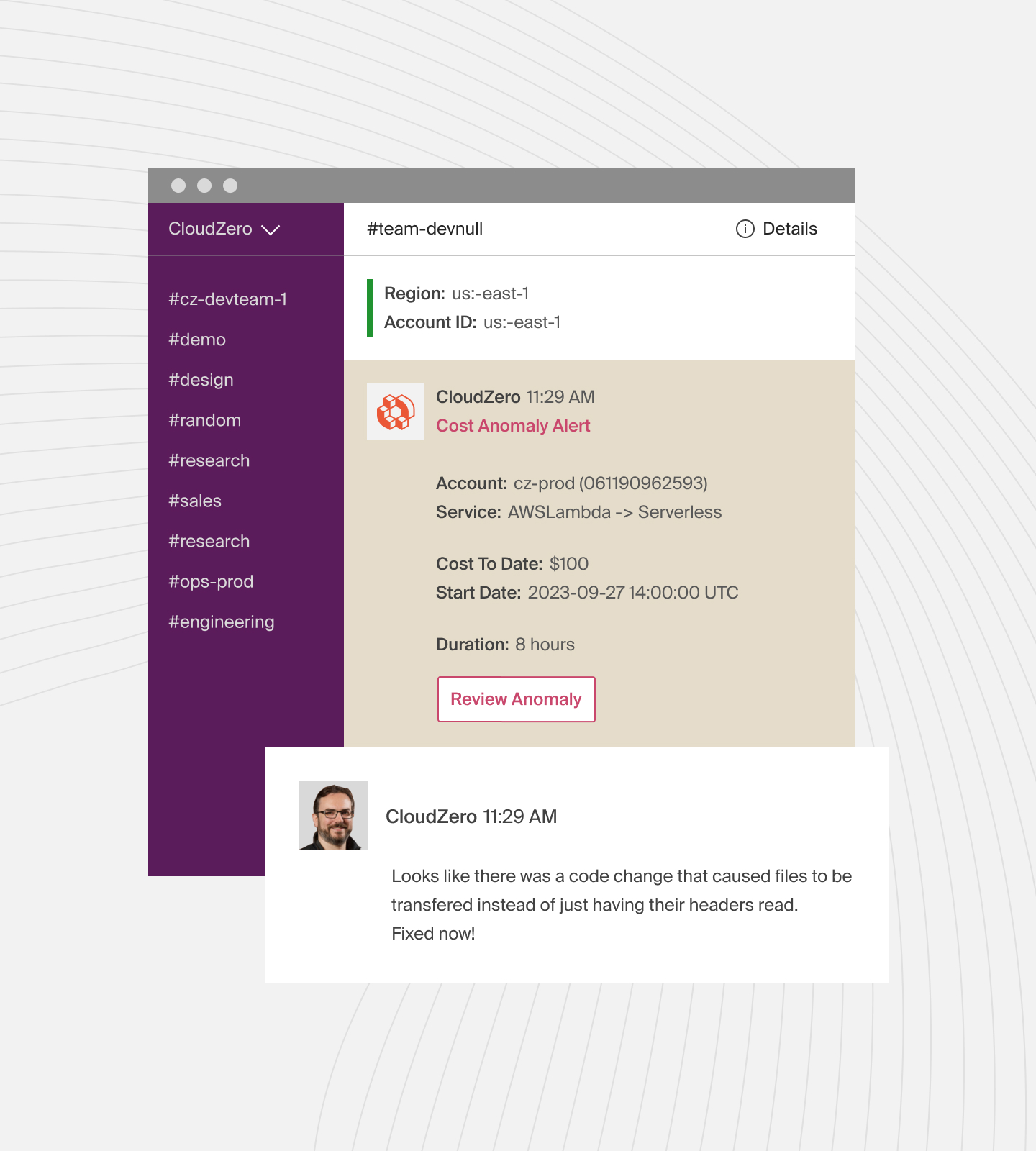
Now it’s your turn.
{{cta(‘566b84f4-56e7-42ab-80be-70900e60024d’)} to see CloudZero in action — and discover why brands like Drift, Remitly, and Klaviyo use CloudZero to save up to $4 million. One of our Cloud Cost Analysts will help you get started!

